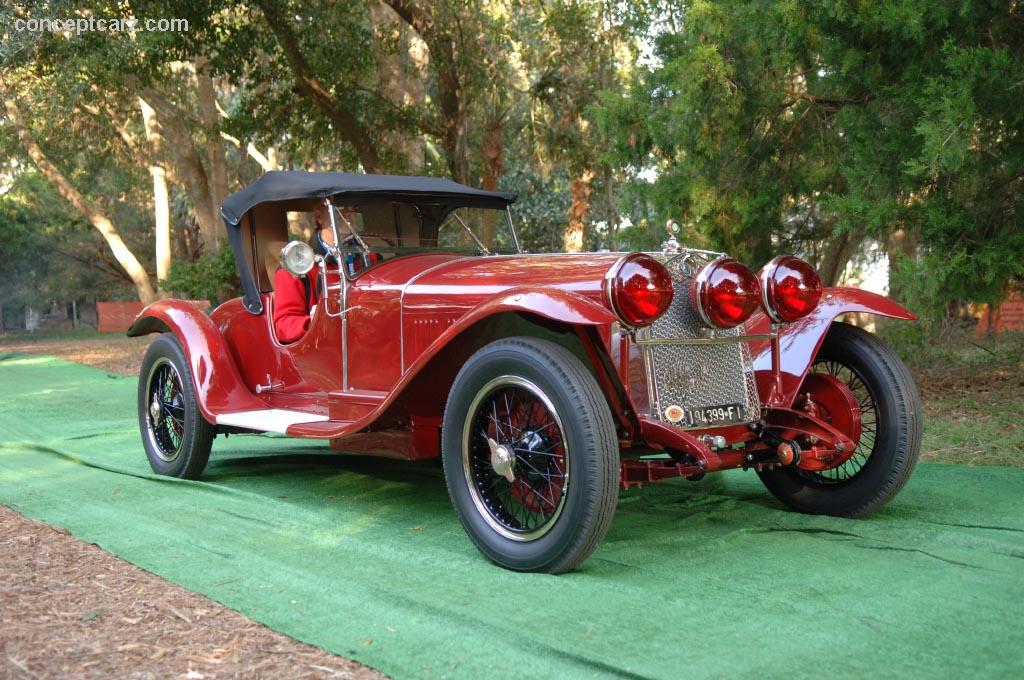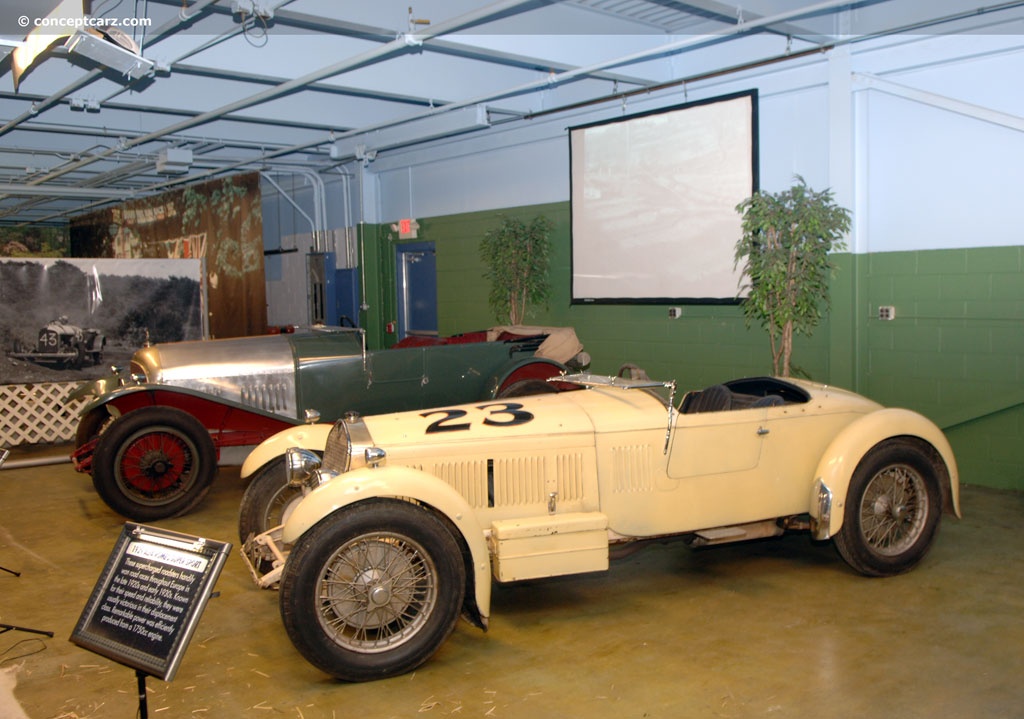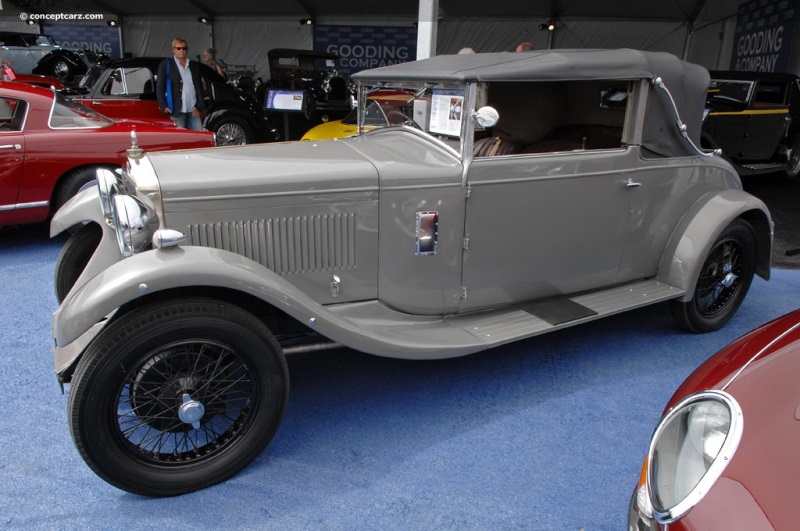The 1922 French Grand Prix at Strasburg and the Italian GP at Monza were both won by the new Fiat Tipo 804, with the design courtesy of Tranquillo Zerbi. The Fiat racing department included many of the era's greatest innovators who were actively recruited by other teams to help with their racing programs. One of them was Vincenzo Bertarione who crossed the English Channel to design the 1923 Sunbeam which then won the French Grand Prix at Tours. Another Fiat team member left Turin near the close of 1923, but his journey was much shorter, traveling to Milan to join Alfa Romeo. His name was Vittorio Jano and he would become one of the greatest and influential of all Italian automotive engineers of all time. He had been persuaded to leave FIAT's racing department for Alfa Romeo by a man named Enzo Ferrari. 
Spyder by Carrozzeria Sport SA
View info and historyVittorio Jano was tasked by Alfa Romeo with designing a new Grand Prix car to replace the P1 created by Giuseppe Merosi. The P1 had appeared only in practice at Monza for the Italian Grand Prix in 1923, where Fiat won convincingly. The result of Janos' work was called the P2 that participated successfully in 2-Liter Formula and Formula Libre events, and in a modified form, until the end of 1930. The P2 was powered by a straight-eight engine that was designed to accept a supercharger. It won both the French and Italian Grand Prix in 1924, and the following year at the French Grand Prix, Antonio Ascari (father of Alberto - the 1952 and 1953 World Champion) was killed while driving a P2. The other cars were withdrawn but they won their other two main Grand Prix races that year at Spa and Monza. The P2 became obsolete for Grand Prix use in 1926 when regulations changes dictated a lower maximum displacement.Along with designing the P2, Jano designed a new straight six-cylinder OHC engine for the road, replacing the Merosi-designed RL and RM models. Merosi's L-head 6- and 4-cylinder cars were powerful but dated, and Alfa Romeo's growing reputation needed a road-going car to complement their competition prowess. Jano's clean-sheet 6C 1500 quickly set new standards for lightweight high-performance motorcars. The 1,487cc inline six-cylinder engine was based on the P2's straight eight and delivered 44 horsepower in single-overhead-camshaft Normale form. The iron cylinder block and head were each single piece castings, and the block was mated to a light alloy crankcase. The Normale and Sport received a single carburetor with the former having a 6.75:1 compression ratio while the latter used a 6.0:1 ratio. The Super Sport used a single carburetor when equipped with a supercharged and a twin-choke carburetor setup in naturally aspirated guise. 
Spyder by Carrozzeria Sport SA
View info and historyThe Tipo 6C 1500 was presented in bare chassis near the end of 1925 at various European Motor Shows. Production of the '6C' lasted from 1927 through 1954 in various configurations, with the name referencing the car's straight-six engine. Coachwork was provided by numerous coachbuilders including Touring Superleggera, Castagna, Zagato, James Young, and Pinin Farina. An Alfa Romeo-factory built body, constructed in Portello, began in 1933.The Tipo 6C 1500 was based on the P2 Grand Prix car and used a steel frame suspended by a conventional suspension setup consisting of live axles and semi-elliptic leaf springs. Special alloys were used resulting in many of the parts being far lighter than similar parts used previously and by other makers of the time. The wheelbase was 2.92m (2900MM) for the Sport and Super Sport versions and a larger 3.10m (3100mm) platform for cars fitted with more formal bodywork. The engine came in three main forms, the single OHC (Normale), twin OHC (Sport) and twin OHC with a blower (Super Sport). The addition of the blower required the engine to be placed back in the frame to allow for the blower to be driven off the nose of the crankshaft. The twin-cam version was usually fitted with a detachable head, while the Normale had the cylinder block and head in one unit. Some of the Super Sports (the Mille Miglia Speciale) had the block and head in one unit called 'testa fissa'. All types had five main bearings (except for a very few later testa fissa engines that had eight) and the overhead camshafts were driven via a vertical shaft at the rear of the block. Water pump and dynamo were also driven off the rear of the crankshaft via a set of cross-shaft gears. The cylinder head featured Jano's unique valve adjusting arrangement using a special tool.
Spyder
View info and historyProduction of the Normale version began in 1927 and most of the coachwork was formal. The Sport version often received open bodywork but more usually 'cabriolet' or 'drophead coupe' rather than 'spider.' The Alfa Romeo factory race cars used, almost exclusively, the Super Sport with the Testa Fissa engines. These cars had the fuel tank positioned directly behind the driver, and along with a revised engine position, resulted in optimal weight distribution and exceptional handling. These cars were successful during 1927, mostly in local Italian events including hillclimbs, and in 1928, Campari and Ramponi won the second Mille Miglia in a Super Sport. Various successes around Europe soon followed.The Alfa Romeo 6C 1750
In 1929, the engine displacement increased to 1,752cc with a bore and stroke of 65x88mm, resulting in a new name, the 6C 17500. The chassis length remained 2.92m (115-inches) and 3.10m (122-inch) for the Turismo, Sport and Gran Turismo, while the Super Sport (SS) version rested on a new platform of 2.745m (108.1-inches). The standard model used a single overhead camshaft engine, while the Super Sport and Gran Sport versions had a double overhead camshaft design, with or without a supercharger. The 6C 1750 was produced in six series between 1929 and 1933. Most examples were sold as a rolling chassis and clothed by Zagato and Touring Superleggera, among others. Three examples were bodied by James Young. The Super Sport versions had their engine placed back, as on the 6C1500 Super Sport, to aid in the addition of a supercharger. A few of the works SS racing cars had Testa Fissa engines that were disguised by tack welding fake head stud nuts on to the top of the engine. These rare engines had a larger bore and delivered 64 horsepower for the naturally aspirated versions while the blown examples delivered 85 horsepower.
Spyder
View info and historyFactory Works 6C1750 race cars won the Mille Miglia in 1929 and 1930 and won the up to 2-litre class in many sports car races across Europe in the following years including the class at Le Mans in 1930 and 1932. They were so successful that they won nearly every major racing event in which they were entered. The 6C 1750 was popular and successful with gentleman drivers, and no fewer than 26 examples competed in the 1929 Mille Miglia, of which 25 finished, six among the first ten. The race was won, for the second consecutive year, by Giuseppe Campari and Giulio Ramponi driving a 6C 1750 SS. Other high-profile victories and accolades include the 24 Hours of Spa Francorchamps, Grand Prix of Ireland, and the 12 Hours of San Sebastian - all in 1929 - plus the 24 Hours of Spa Francorchamps and RAC Tourist Trophy in 1930. Changes were made throughout the production lifespan with the designation continuing up to the 6th Series in 1933 which included a 6C1900 (68mm x 88mm). During this time, Alfa Romeo introduced the 8C2300 in 1931, and was initially intended solely for competition. The company eventually relented, and cars were sold up to and including 1934 when the successor to the 6C1700 was introduced - the 6C2300. This new model had chain-driven overhead camshafts - a first for Alfa Romeo. The 6C2300B introduced Alfa to another 'first' with the use of all round independent suspension. 
Spyder by Touring
Chassis #: 0312901
Engine #: 0312901
View info and history
Auction entries : 4Alfa Romeo produced over one thousand 6C 1500s and approximately 2,635 examples of the 6C1750 between 1929 and 1933. Considering these were hand-assembled cars wearing coachbuilt bodies, the production numbers are monumental.
by Daniel Vaughan | Nov 2021

Spyder by Carrozzeria Sport SA
View info and history

Spyder by Carrozzeria Sport SA
View info and history

Spyder
View info and history
In 1929, the engine displacement increased to 1,752cc with a bore and stroke of 65x88mm, resulting in a new name, the 6C 17500. The chassis length remained 2.92m (115-inches) and 3.10m (122-inch) for the Turismo, Sport and Gran Turismo, while the Super Sport (SS) version rested on a new platform of 2.745m (108.1-inches). The standard model used a single overhead camshaft engine, while the Super Sport and Gran Sport versions had a double overhead camshaft design, with or without a supercharger. The 6C 1750 was produced in six series between 1929 and 1933. Most examples were sold as a rolling chassis and clothed by Zagato and Touring Superleggera, among others. Three examples were bodied by James Young. The Super Sport versions had their engine placed back, as on the 6C1500 Super Sport, to aid in the addition of a supercharger. A few of the works SS racing cars had Testa Fissa engines that were disguised by tack welding fake head stud nuts on to the top of the engine. These rare engines had a larger bore and delivered 64 horsepower for the naturally aspirated versions while the blown examples delivered 85 horsepower.

Spyder
View info and history

Spyder by Touring
Chassis #: 0312901
Engine #: 0312901
View info and history
Auction entries : 4
by Daniel Vaughan | Nov 2021
Related Reading : Alfa Romeo 6C History
The Alfa Romeo 6C 2500 was introduced near the end of the 1930s. The 6C name was derived from the engine size, an inline-six while the 2500 represented the engines cubic-centimeter displacement size. The engine was a version of Vittorio Jano designed a six-cylinder engine. The 6C was available in a plethora of body styles and wheelbases and was produced during two different times in history.....
Continue Reading >>
Continue Reading >>
Similarly Sized Vehicles
from 1929
Alfa Romeo Monthly Sales Volume
March 2023
2,390
1929 Alfa Romeo 6C 1750 Vehicle Profiles
Recent Vehicle Additions
Performance and Specification Comparison
6C 1750 Specification Comparison by Year
Year
Production
Wheelbase
Engine
Prices
Related Automotive News

'Storie Alfa Romeo' Episode 2: Iconic 6C 1750 Foretells Future And Dominates Its Era
In the 1930s, the 6C 1750 possessed the unique ability to win both races and design awards
With outstanding power to weight ratio and perfect balance, the 6C 1750 launched technical traditions that continue today
The flying man from Mantua...

2019 Pebble Beach Concours d'Elegance Best of Show Winner
1931 Bentley 8 Litre Named Best of Show at the 69th Pebble Beach Concours dElegance
PEBBLE BEACH, Calif. (August 18, 2019) — Every August, the history of the automobile rolls onto the competition field of the Pebble Beach Concours dElegance...

Alfa Romeo Named Best of Show at the 68th Pebble Beach Concours d'Elegance
Touring-Bodied Alfa Romeo 8C 2900B Named Best of Show at the 68th Pebble Beach Concours dElegance
PEBBLE BEACH, Calif. (August 26, 2018) — After an intense competition that drew diverse cars from around the globe, the coveted gold Best of Show...

2015 Pebble Beach Concours d'Elegance Best of Show
PEBBLE BEACH, Calif. (August 17, 2015) -- An Italian Isotta Fraschini Tipo 8A Cabriolet that once turned heads and garnered top prizes in the classic era glided to victory at the 65th Pebble Beach Concours dElegance on Sunday.
The competition...
Postwar Ferrari Named Best of Show at 2014 Pebble Beach Concours d'Elegance
1954 Ferrari 375 MM Scaglietti Coupe Named Best of Show
PEBBLE BEACH, Calif. (August 17, 2014) -- Excited cheers echoed across the 18th fairway of Pebble Beach Golf Links Sunday when a 1954 Ferrari 375 MM Scaglietti Coupe was named Best of...







































